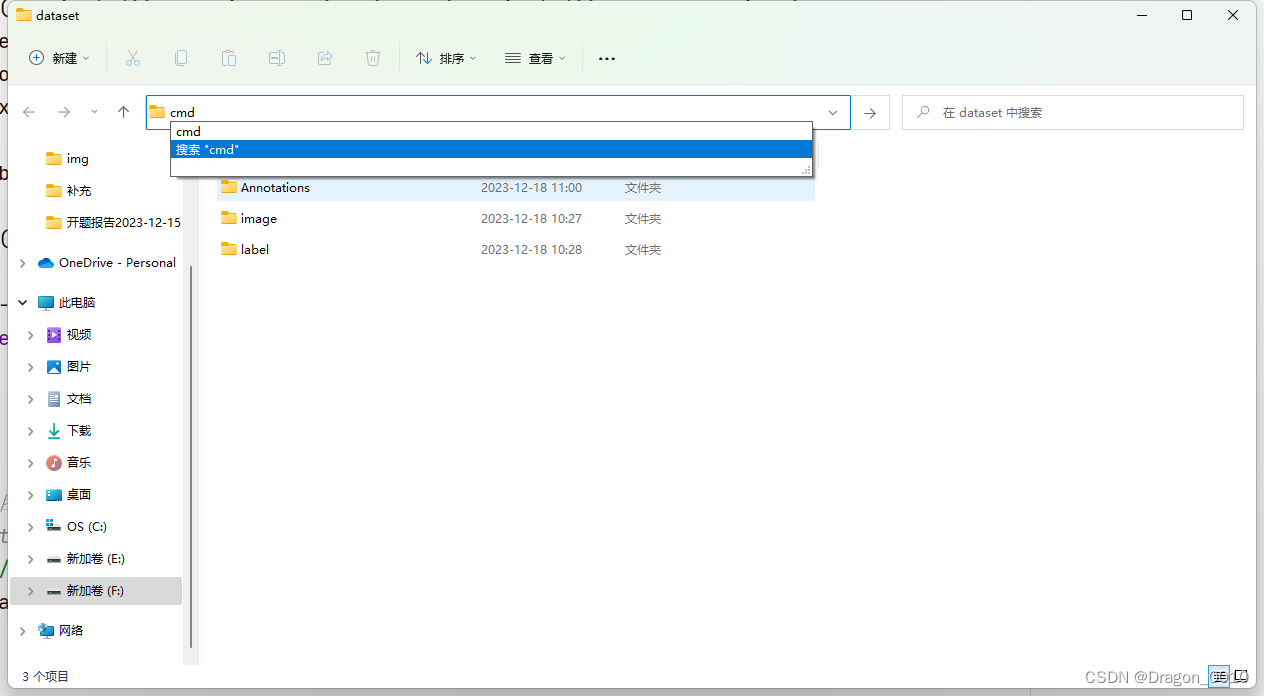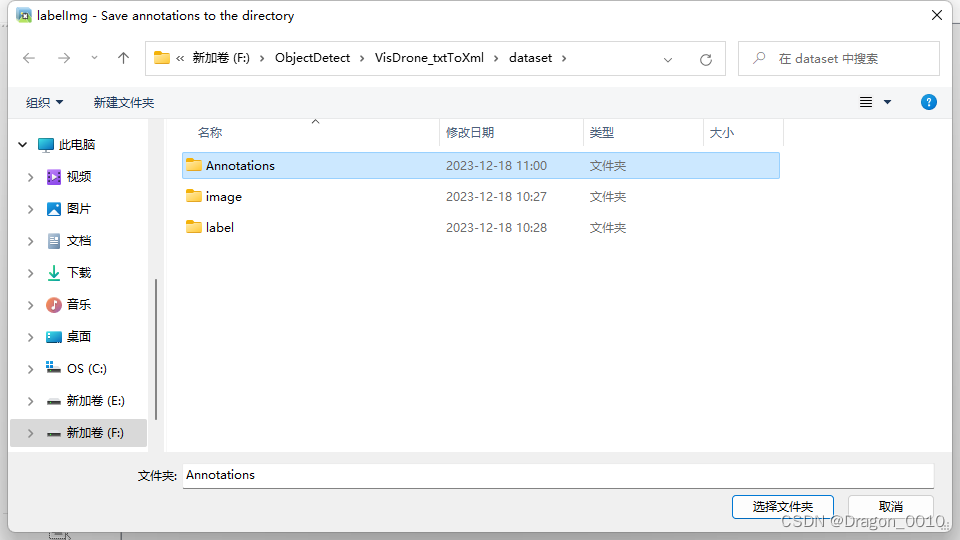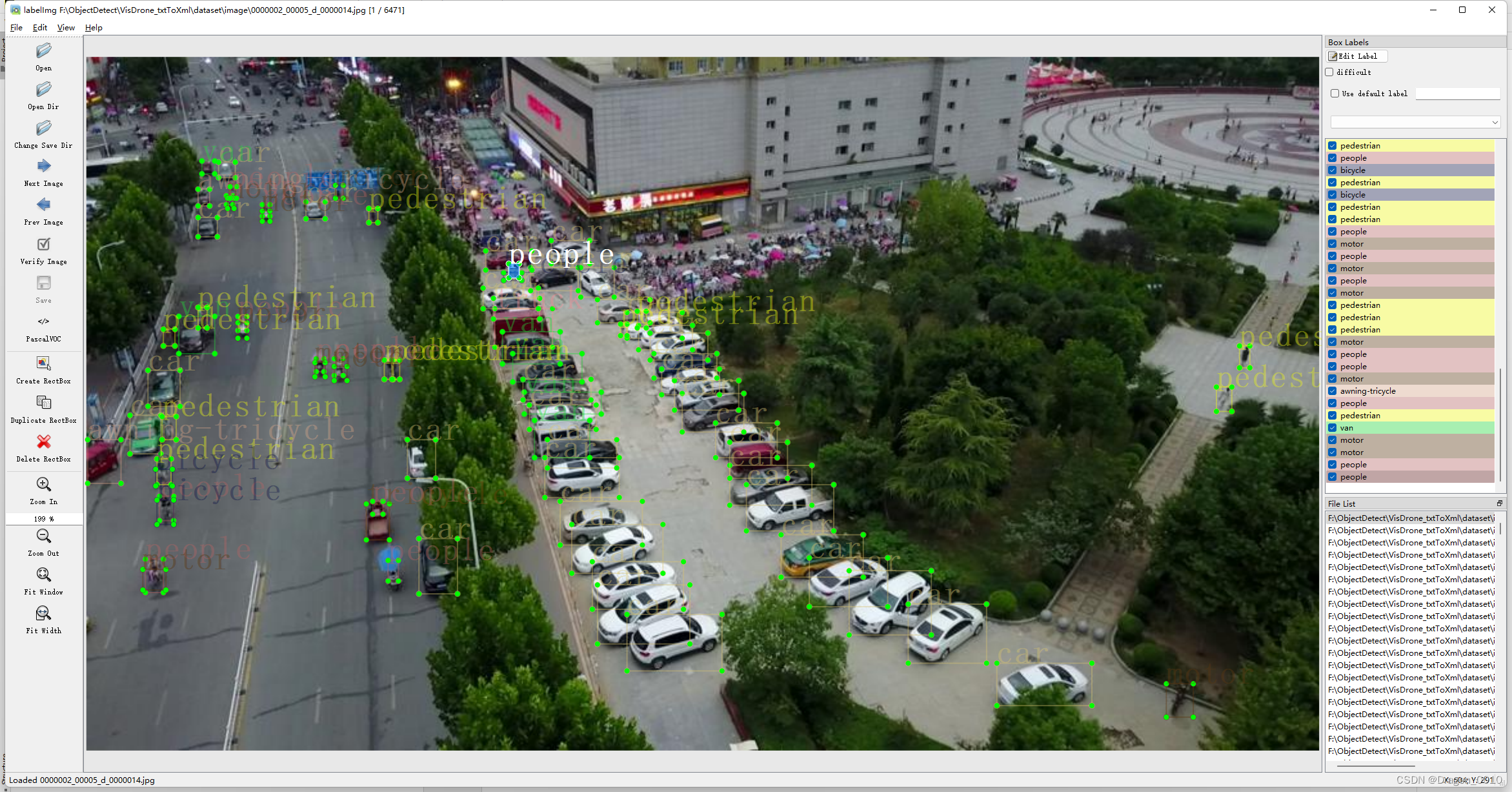1.文件目录如下所示:

对以上目录的解释:
1.dataset下面的image文件夹:里面装的是数据集的原图片

2.dataset下面的label文件夹:里面装的是图片对应得yolo格式标签

3.dataset下面的Annotations文件夹:这是一个空文件夹,里面要装得是即将要生成得voc格式标签
2.转换代码如下所示
新建一个convert.py文件,然后将下面代码复制进去
注意:文件夹的格式要与我的一样才行
from xml.dom.minidom import Document
import os
import cv2# def makexml(txtPath, xmlPath, picPath): # txt所在文件夹路径,xml文件保存路径,图片所在文件夹路径
def makexml(picPath, txtPath, xmlPath): # txt所在文件夹路径,xml文件保存路径,图片所在文件夹路径"""此函数用于将yolo格式txt标注文件转换为voc格式xml标注文件"""dic = {'0': "pedestrian", # 创建字典用来对类型进行转换'1': "people", # 此处的字典要与自己的classes.txt文件中的类对应,且顺序要一致'2': "bicycle",'3': "car",'4': "van",'5': "truck",'6': "tricycle",'7': "awning-tricycle",'8': "bus",'9': "motor",}files = os.listdir(txtPath)for i, name in enumerate(files):xmlBuilder = Document()annotation = xmlBuilder.createElement("annotation") # 创建annotation标签xmlBuilder.appendChild(annotation)txtFile = open(txtPath + name)txtList = txtFile.readlines()img = cv2.imread(picPath + name[0:-4] + ".jpg")Pheight, Pwidth, Pdepth = img.shapefolder = xmlBuilder.createElement("folder") # folder标签foldercontent = xmlBuilder.createTextNode("driving_annotation_dataset")folder.appendChild(foldercontent)annotation.appendChild(folder) # folder标签结束filename = xmlBuilder.createElement("filename") # filename标签filenamecontent = xmlBuilder.createTextNode(name[0:-4] + ".jpg")filename.appendChild(filenamecontent)annotation.appendChild(filename) # filename标签结束size = xmlBuilder.createElement("size") # size标签width = xmlBuilder.createElement("width") # size子标签widthwidthcontent = xmlBuilder.createTextNode(str(Pwidth))width.appendChild(widthcontent)size.appendChild(width) # size子标签width结束height = xmlBuilder.createElement("height") # size子标签heightheightcontent = xmlBuilder.createTextNode(str(Pheight))height.appendChild(heightcontent)size.appendChild(height) # size子标签height结束depth = xmlBuilder.createElement("depth") # size子标签depthdepthcontent = xmlBuilder.createTextNode(str(Pdepth))depth.appendChild(depthcontent)size.appendChild(depth) # size子标签depth结束annotation.appendChild(size) # size标签结束for j in txtList:oneline = j.strip().split(" ")object = xmlBuilder.createElement("object") # object 标签picname = xmlBuilder.createElement("name") # name标签namecontent = xmlBuilder.createTextNode(dic[oneline[0]])picname.appendChild(namecontent)object.appendChild(picname) # name标签结束pose = xmlBuilder.createElement("pose") # pose标签posecontent = xmlBuilder.createTextNode("Unspecified")pose.appendChild(posecontent)object.appendChild(pose) # pose标签结束truncated = xmlBuilder.createElement("truncated") # truncated标签truncatedContent = xmlBuilder.createTextNode("0")truncated.appendChild(truncatedContent)object.appendChild(truncated) # truncated标签结束difficult = xmlBuilder.createElement("difficult") # difficult标签difficultcontent = xmlBuilder.createTextNode("0")difficult.appendChild(difficultcontent)object.appendChild(difficult) # difficult标签结束bndbox = xmlBuilder.createElement("bndbox") # bndbox标签xmin = xmlBuilder.createElement("xmin") # xmin标签mathData = int(((float(oneline[1])) * Pwidth + 1) - (float(oneline[3])) * 0.5 * Pwidth)xminContent = xmlBuilder.createTextNode(str(mathData))xmin.appendChild(xminContent)bndbox.appendChild(xmin) # xmin标签结束ymin = xmlBuilder.createElement("ymin") # ymin标签mathData = int(((float(oneline[2])) * Pheight + 1) - (float(oneline[4])) * 0.5 * Pheight)yminContent = xmlBuilder.createTextNode(str(mathData))ymin.appendChild(yminContent)bndbox.appendChild(ymin) # ymin标签结束xmax = xmlBuilder.createElement("xmax") # xmax标签mathData = int(((float(oneline[1])) * Pwidth + 1) + (float(oneline[3])) * 0.5 * Pwidth)xmaxContent = xmlBuilder.createTextNode(str(mathData))xmax.appendChild(xmaxContent)bndbox.appendChild(xmax) # xmax标签结束ymax = xmlBuilder.createElement("ymax") # ymax标签mathData = int(((float(oneline[2])) * Pheight + 1) + (float(oneline[4])) * 0.5 * Pheight)ymaxContent = xmlBuilder.createTextNode(str(mathData))ymax.appendChild(ymaxContent)bndbox.appendChild(ymax) # ymax标签结束object.appendChild(bndbox) # bndbox标签结束annotation.appendChild(object) # object标签结束f = open(xmlPath + name[0:-4] + ".xml", 'w')xmlBuilder.writexml(f, indent='\t', newl='\n', addindent='\t', encoding='utf-8')f.close()if __name__ == "__main__":picPath = "dataset/image/" # 图片所在文件夹路径,后面的/一定要带上txtPath = "dataset/label/" # txt所在文件夹路径,后面的/一定要带上xmlPath = "dataset/Annotations/" # xml文件保存路径,后面的/一定要带上makexml(picPath, txtPath, xmlPath)3.需要修改的地方-标签字典
如果你要转换得标签内容与上面标签字典得内容不同得话,请按需求修改成你自己的标签

4.需要修改的地方-文件夹路径
如果你的文件夹路径跟我上面的不一样的话,那么在这里修改成你对应的文件夹路径

5.运行你刚刚创建的convert.py文件,就生成xml格式的标签了

6.使用labelimg验证一下转换之后的格式
先打开图片和标签所在的文件夹

在这里输入cmd


打开命令行窗口

先激活虚拟环境,输入命令:
activate yolo
然后使用labelimg验证
labelimg image在选择标签文件夹的时候选择刚才生成的voc格式标签的文件夹

然后进入页面就是这个样子

说明转换格式成功啦!!!









![[PHP]四舍五入保留两位小数](http://pic.xiahunao.cn/[PHP]四舍五入保留两位小数)






)

libpq的两套实现(socket/shm_mq))
